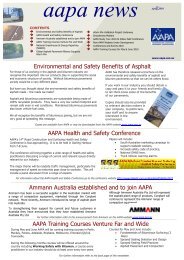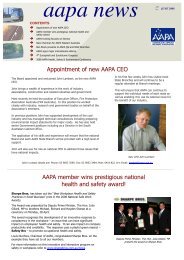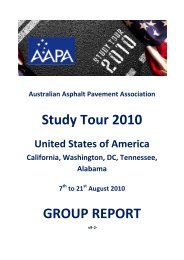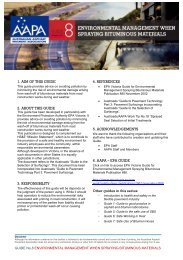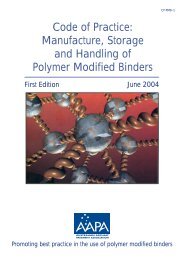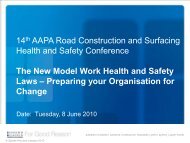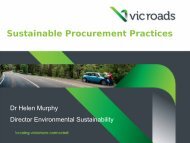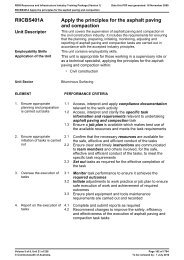Asphalt Review - Volume 32 Number 3 (Jun / Juy 12) - Australian ...
Asphalt Review - Volume 32 Number 3 (Jun / Juy 12) - Australian ...
Asphalt Review - Volume 32 Number 3 (Jun / Juy 12) - Australian ...
Create successful ePaper yourself
Turn your PDF publications into a flip-book with our unique Google optimized e-Paper software.
ASPHALT REVIEWCEO’S REPORTJohn Lambert,CEO, AAPAThose of us living in the south of Australia willbe noticing that the weather has become coldand sometimes wet.As winter approaches, it reminds me ofthe importance of good quality roads, roadsthat we feel safe to drive on. This requiresgood quality and maintained asphalt or sealedroads. It also requires well marked roads as isdone by our colleagues in the Road MarkingIndustry Association.Wet weather is also a time when conditionsdo not allow for roads to be properly surfaced.This may be winter periods in the south andthe monsoonal periods in the north. Althoughthese periods may be down time for surfacing,they give companies the opportunity toprovide training for work crews.In the Chairman’s report in this edition of<strong>Asphalt</strong> <strong>Review</strong>, Sergio Cinerari highlights theimportance of worksite safety. Wet periodsare a great opportunity to provide training forcrews in health and safety, as well as in a rangeof other directly relevant areas of our work.Health and safety training ensures thatnew workers understand the risks. It alsoreminds experienced workers of the risksand reduces the likelihood of these workersbecoming complacent.The AAPA Working Safely with Bitumentraining course is one way workers canbetter understand the risks associated withhandling hot bitumen. This course should bedone by every new worker in their first year.Experienced workers should also complete thecourse every four or five years to remind themof the risks. AAPA is also developing a short,on-line induction course that new workerswill be able to do as soon as they commencework. It will also be available for experiencedworkers to do annually as a refresher course.Information on the Working Safely withBitumen course is available on the AAPA websitealong with a calendar of scheduled courses.Additional courses can also be provided upondemand. Please contact the AAPA office if youwish to inquire about a course.As well as training in the handling ofbitumen, the wet periods across Australiaprovide the opportunity for workers toreview their safety procedures such asthose associated with working in a confinedworksite with moving vehicles and workingwith passing traffic on sites where the roadhas not been able to be closed. Regular toolbox meetings throughout the year shouldalso stress these issues.Wet periods also provide a time to provide arange of training in other areas and AAPA offersa range of relevant courses including courses onasphalt placement and compaction and sprayedsurfacing. Information on these courses canalso be found on the AAPA website.At the time this edition of <strong>Asphalt</strong> <strong>Review</strong>was being prepared, the Eurasphalt andEurobitume Congress was being held atIstanbul in Turkey.This congress attracted delegates fromEurope and the rest of the world. It is heldevery four years and has a wide range ofrelevant papers, displays and exhibitions.The theme for this year’s Congress was<strong>Asphalt</strong>, the sustainable road to success.A delegation of AAPA members fromAustralia attended the congress and some ofthe most relevant papers will be printed in thenext edition of <strong>Asphalt</strong> <strong>Review</strong>.The <strong>Australian</strong> delegation was alsoundertaking a study tour of Europe, visitingresearch organisations, government roadauthorities and industries in the UK, France,Netherlands, Turkey and Germany.Delegates on the tour identified five keyareas of information.• Long Life Pavements;• High Performance <strong>Asphalt</strong> and Binders;• Sustainability;• Health and Safety; and• Procurement Systems.They also identified over 250 questions thatthey forwarded to the organisations they werevisiting to ensure that the people being metwere able to prepare.The AAPA WorkingSafely with Bitumentraining course is oneway workers canbetter understand therisks associated withhandling hot bitumen.This course shouldbe done by everynew worker intheir first year.As with previous study tours, AAPA willbe holding feedback sessions providinginformation on the outcomes of the tours.These will be held in each of the larger capitalcities. Information on these feedback sessionswill be provided on the AAPA website and inmembers’ newsletters.Before finishing this report I shouldcomment on the recent changes being madeto state government specifications relatingto warm mix (WMA) and reclaimed asphaltpavement (RAP). The AAPA/AustroadsWarm Mix Validation Project has now beencompleted and, even though the final reporthas not been finalised, it is obvious that thehypothesis that warm mix performs the sameas hot mix has been proven to be correct.It is clear that warm mix should bepermitted and is it pleasing to note that theRoads and Maritime Services in NSW hasalready included WMA in its specification.Vicroads is also in the process of amendingits specifications. The use of RAP, includingin WMA is also increasing and it is clear thatin hot mix amounts of 15% should be readilypermitted and even higher percentages inwarm mix.We can often be slow in Australia to pickup technologies that have been provenoverseas. While it is appropriate to movecautiously, I believe that in the case of warmmix and RAP, it has been proven sufficientlyto allow the use of both without unnecessaryrestrictions. The advantages of these twotechnologies, particularly the cost andenvironmental advantages of RAP, mean thatwe should be using these technologies acrossthe whole of Australia. ■30 ROADS JUNE/JULY 20<strong>12</strong>



